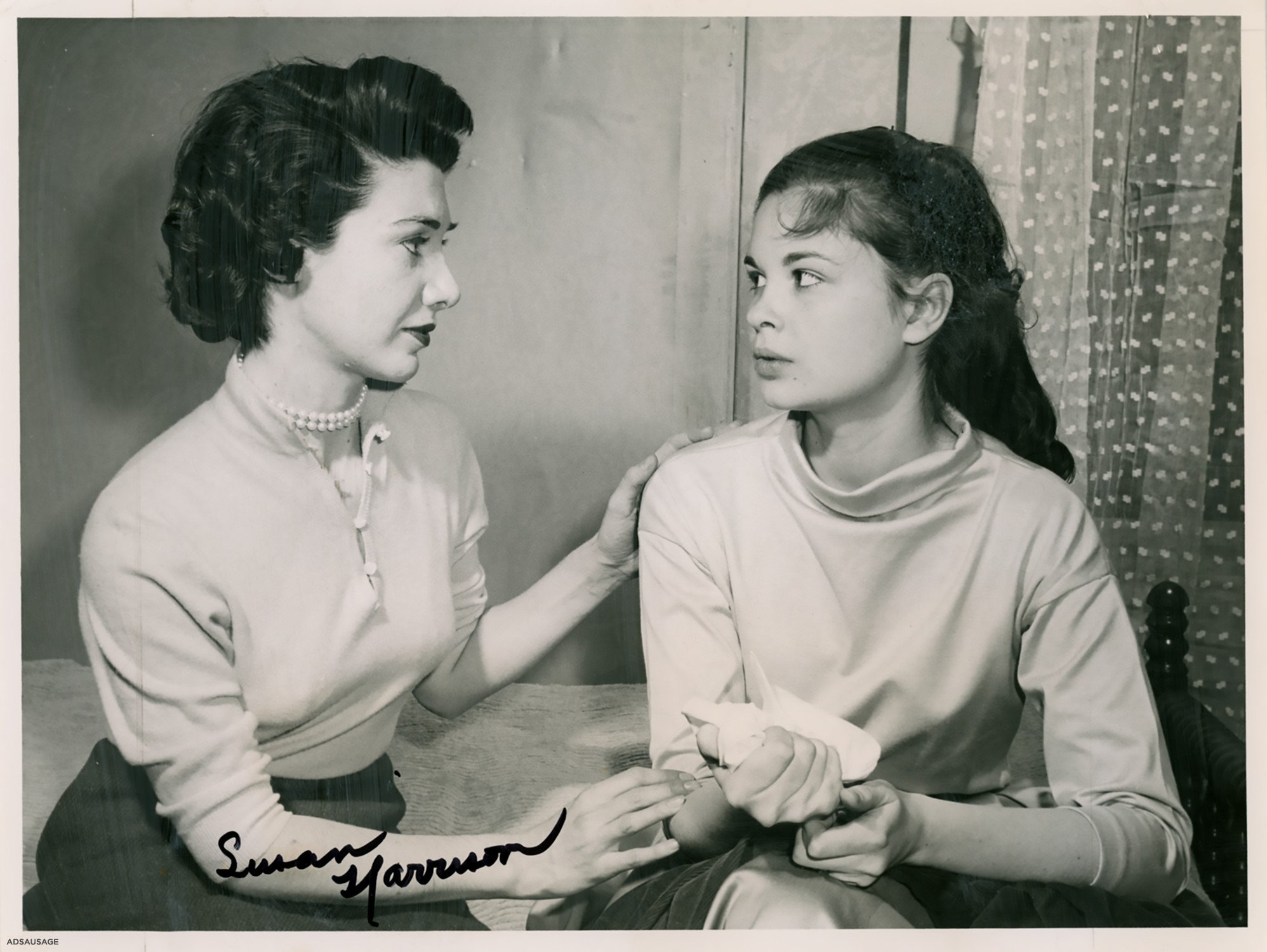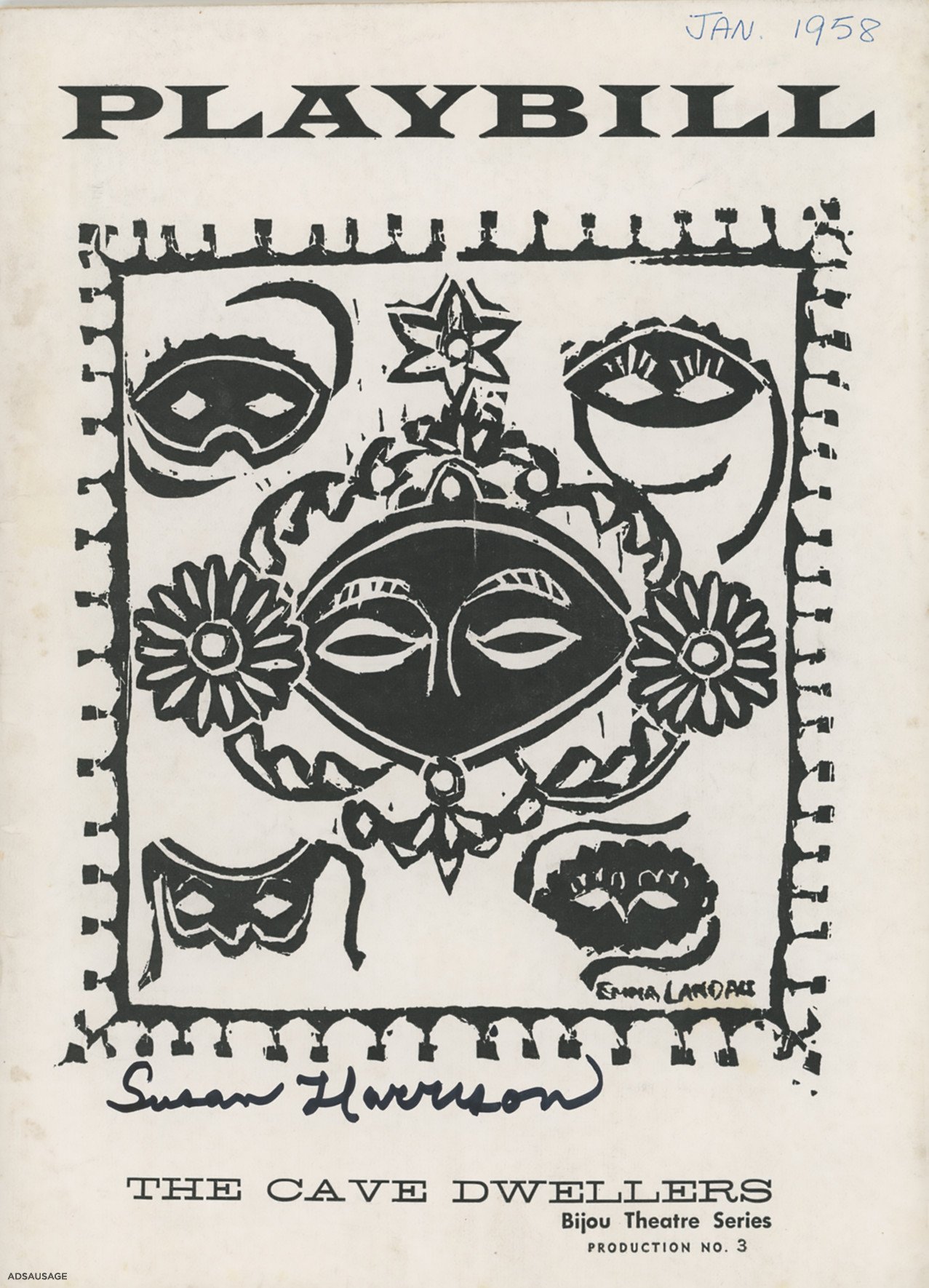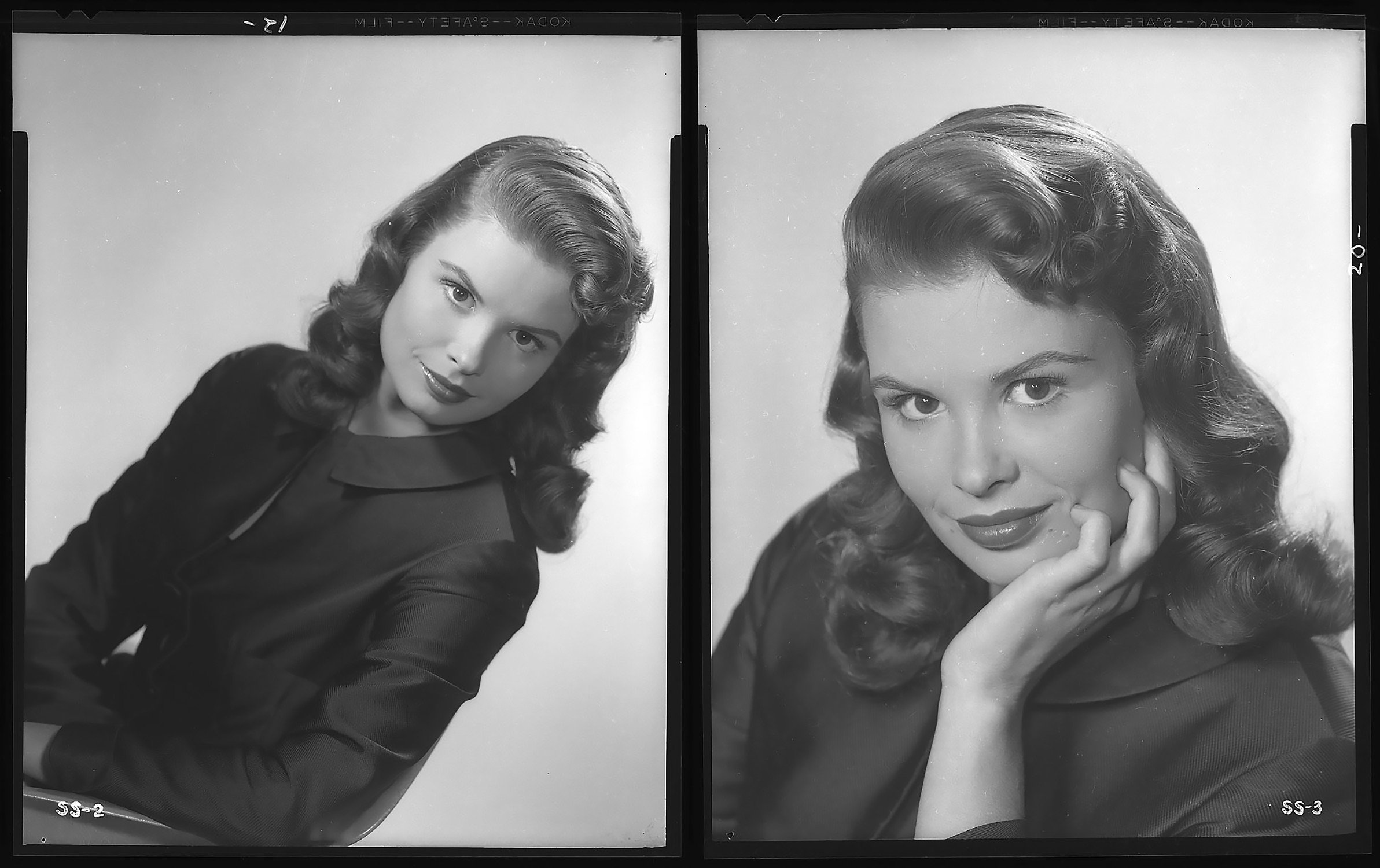Goodbye, Baby
Actress Susan Harrison passed away in March 2019. Although her death garnered some media attention, few people connected with her passing. This may be understandable; her film and television career was short-lived, and her name faded into obscurity. No sooner had she appeared on our screens than she disappeared from the spotlight. Susan Harrison is not merely a footnote in film history, but sadly, her story serves as a cautionary tale.
And yet her scant film credits include a seminal landmark movie that was perhaps a blessing and a curse, considering it was her debut at only nineteen years old.
Although a 1956 press release called her "Bronx-born," Susan Stewart Harrison was born in Leesburg, Florida, in 1938. Her younger siblings were Marta, Jack, and Gillian, who passed away in 2020. After moving to New York, Susan graduated from Christopher Columbus High School in the Bronx, and later studied at the School of Performing Arts (renamed Jacqueline Kennedy Onassis High School).
According to the same polished press release, Susan Harrison waited tables at Vesuvius, a pizza joint on Wall Street, and the Limelight club in Greenwich Village. It continued to say she briefly worked as a model in the garment center.
That might have been the sole credible line, as the "18-year-old girl with the dark looks of a Brontë heroine" did indeed model for various magazines, and worked with noted photographers Peter Basch and Earl Leaf.
Unfortunately, her modeling career was marked by a strange incident in August 1956 when she suffered a back injury falling 10 feet through an opening in a patio roof. The accident occurred during a photoshoot with writer Rick Strauss and photographer Peter Basch.
Susan filed suit, asking for $100,000 in damages. The settlement was reduced to $7,500.
The incident on Marmont Avenue in West Hollywood was referenced in a piece Susan wrote for Ivy Wilson's Hollywood Album, titled I Am Me.
When accidents do happen to a person, it is because in some way he was looking for it, or asking for it, or heading for it. I feel [sic] through a roof one time, about twenty feet to a concrete floor. Luckily, the result was only a couple of broken vertebrae. Everyone was surprised to find me alive. This accident, I am sure, was brought on because I had thought, deep down, of killing myself because I was very depressed.
With the court case behind her, Susan’s next role was a high-school valedictorian caring for her dying Uncle in the ABC drama, Star Tonight.
Susan Harrison and Claire Kiley in Can You Coffeepot on Skates?
Susan appeared in several magazines, including Seventeen and Harper's Bazaar, with accompanying photos by Bob Willoughby. The article 'Bonjour Success' noted that Susan had tried out for Way Out West and The Tall Dark Man. The article further stated that she secured both roles. Not true.
The projects belonged to her future producing team of Harold Hecht, James Hill, and Burt Lancaster, yet neither project materialized.
Strangely, the article also announced the possibility of landing that year's most coveted role, Cecile, in Otto Preminger's Bonjour Tristesse. That part went to Jean Seberg.
Sweet Smell of Success
By 1956, newspapers announced that actors Burt Lancaster and Tony Curtis, who had appeared in Carol Reed's circus-themed film Trapeze, would co-star in a new movie titled
Sweet Smell of Success for United Artists.
Additionally, it was reported that actor Martin Milner had been signed for the romantic lead role as Steve, a clean-cut jazz musician. Initial reports indicated that Ernest Borgnine would be part of the cast; however, he was replaced by veteran actor Sam Levene, who had previously worked with Lancaster on Broadway in Sound of Hunting and in the film The Killers.
Other names that were considered for the role included Elaine Stewart, who was unable to be released from her MGM contract, and Claire Fitzpatrick, a favorite of gossip columnists. Fitzpatrick, a model from Long Island, had been crowned 'Miss Irish USA.'
When Hecht-Lancaster said they were going to use unknown players in their pictures, they weren't kidding. They signed Susan Harrison, 18, who has never acted before, to play opposite Burt Lancaster and Tony Curtis in Sweet Smell of Success.Susan was a waitress on Wall Street and Greenwich Village. Max Arnow found her in New York, gave her a film test, brought her here and she's now set for a leading role.Hollywood by Hedda Hopper/The Daily News. October 19th, 1956
Max Arnow, a well-known talent scout at Warner Bros. and Columbia, later formed Artists and Productions Associates with fellow industry players Blake Edwards and Jack Lemmon.
Produced by the Beverly Hills-based production team of Harold Hecht, James Hill, and Lancaster, the hard-boiled drama about ruthless gossip columnist J.J. Hunsecker and his unscrupulous press agent Sidney Falco was based on Ernest Lehman's magazine story.
For the movie, Clifford Odets handled the screenplay, and British director Alexander Mackendrick directed. Shooting in New York City began in October 1956. The interiors were filmed in Hollywood at Goldwyn Studios' Soundstage 8.
Good fortune was around the corner when Hedda Hopper named Susan one of her 'Top Movie Discoveries During 1956'. The illustrious list also included Jayne Mansfield and Jean Seberg.
Less fortuitous would be her marriage to nightclub singer Andre Phillipe.
Phillipe, whose real name was Everett Cooper, could easily have mixed with the seedy milieu of Sweet Smell of Success. Born in the Bronx, Cooper began singing in the early 1950s using his more Continental-sounding pseudonym.
Something of a lothario, Phillipe's name was attached to various Hollywood ladies, including Judy Garland, Nina Foch, Shelley Winters, and even Marlon Brando's one-time fiancée Josanne Mariani-Berenger. Having wowed cafe society, the wily Phillipe maneuvered his way into film and television, appearing most notably in bit parts for director Paul Mazursky in the 1970s. Cooper died in 2007.
Tonight's gossip... tomorrow's gospel!
Released June 27th, 1957, Sweet Smell of Success bowed at the air-conditioned Loew's State Theatre in New York. Reviews were mixed. While some acknowledged the sharp writing and terrific performances, others struggled with the lack of sympathetic characters. Writing for Brooklyn's Tablet Newspaper in July 1957, one critic said, "It is an ugly, nasty picture, possibly too involved for many people even to follow."
No Mass Appeal Theme
Technically of a high caliber, the picture is probably not destined for universal acclaim or appreciation despite the marquee attraction of Lancaster and Curtis... The theme and treatment are too isolated for mass appeal. Dorothy Masters, The Daily News. June 28th, 1957
Susan Harrison left her mark in a movie that would never be forgiven or forgotten. Playing JJ's screwball sister, Susie, the young newcomer appears almost 15 minutes into the black-and-white picture. Standing in the courtyard behind a jazz club, wrapped in a platina mink coat with the camera approaching for a closeup, Susan Harrison slowly turns to co-star Marty Milner and gently utters her first line, "Steve... I'll try to make you a good wife."
Her soft face is perfection. Her voice is not strong enough to crack eggshells. As Susie Hunsecker, she plays the fragile kid sister of cold, cutthroat columnist JJ Hunsecker with a sense of trepidation and delicate beauty, indeed close to home.
Despite her brittle aura, Susie Hunsecker saw through an unscrupulous operator like Falco. We witness this early on.
Toots Shor in New York. Illustration by Alan Dunn. From The Wonderful World of Toots Shor by John Bainbridge, 1951 (Houghton Mifflin).
Leaving the jazz club, they share a cab, where the conversation quickly turns to her budding romance. Falco, of course, not inquiring out of any genuine interest, is tasked with breaking up the lovebirds purely at JJ's behest.
As JJ would tell his sister later, "Don't ever tell anyone Susie how I'm tied to your apron strings".
While they trade barbs in the taxi, Falco tells her that JJ is one of his best friends. Unconvinced of this performance, Susie smiles and deliberately says, "I know. But someday I'd like to look into your clever mind and see what you really think of him".
Susie, JJ happens to be one of my very best friends.”
Indignant, Falco scolds her for such a comment, but Susie looks down and quietly responds, "Who could love a man who keeps jumping through burning hoops like a trained poodle?"
This exchange is a beautiful moment, and something is comforting in Susie's insightfulness, especially given her treatment by those around her. Aside from the doomed boyfriend and his genial manager, Susie Hunsecker is alone. Not even Mary, JJ's astute secretary, is compelled to comfort her after Susie's meltdown later in the movie.
Susan herself was unhappy with her performance. When asked what she thought of herself, Harrison told columnist Mel Heimer, "Awful. Although they cut my best scenes."
While Lancaster and Curtis received their best notices, the supporting cast was equally worthy: Jeff (Jean Marie) Donell as Sally, the eager but disparaged wide-eyed assistant who lies for Sidney but pays the rent (the tailor can wait). Edith Atwater, as JJ's secretary, delegates his manic episodes. Lurene Tuttle as Loretta Bartha, who discovers her gossip columnist husband was kidding around with a cigarette girl.
And the great Barbara Nichols as Rita, the cigarette girl. Put her in a tropical island mood, and she takes out all her hairpins (leave the key under the mat).
Given the fairy tale-like circumstances of being plucked from obscurity, the inexperienced Susan Harrison surprisingly handled her first professional role well. Critics took notice: "Miss Harrison, as Hunsecker's sister, is totally convincing in her first acting job."
Working alongside the imposing Burt Lancaster and frenetic Tony Curtis must have been daunting. Yet her mannered performance struck the right note, going from demure and bird-like under her brother's leering gaze to shrewd and victorious at the finish line.
Her fragile state of mind was on the screen, sometimes her voice breaking and fading to a whisper.
Despite being named one of the best movies of 1957 by Time Magazine, Sweet Smell of Success was considered a box office failure - reportedly losing $500,000 for HHL. In its wake, Susan was overlooked, and the experience labeled the young actress everything from 'beatnik' to 'Hollywood rebel.' It must have been a tumultuous time. Compounding matters was that her marriage to Andre Phillipe ended when the movie wrapped.
Theater
In early 1958, Susan appeared in William Saroyan's The Cave Dwellers at the Bijou Theater in New York. The cast included stage actress Eugenie Leontovich, who made an indelible impression four years later on screen in William Castle's Homicidal as Helga, a wheelchair-bound deaf-mute.
The Cave Dwellers was well received. Critic John Chapman for the Daily News called The Cave Dwellers "a warm, lovely play, splendidly staged and acted." Chapman noted Susan Harrison, calling her debut "an impressive one" and noted, "she is an actress of extraordinary sensitivity".
The following year was quiet regarding work, but Susan's personal life gained momentum with her new husband, Joel Colin. They had a son and spent two years in Arizona. As Susan explained, "It was a time of thought for me. I spent most of my time just watching mirages on the desert - and thinking - and the torment left my soul."
Newspapers called Susan's following motion picture a comeback by labeling the actress a 'reformed beatnik' while mentioning troubled actress Diane Varsi in the same breath. Citing early stardom at such a young age as the cause for her time away, Susan was quoted as saying she was a "tormented soul" back then.
I was an exploitable commodity. I had no one to really advise me who really cared for me. I married singer Andre Phillipe but he was as bewildered as I. Now I have someone who really cares for me and my welfare. I can face Hollywood as a mature person.
Susan Harrison, 1959
The Small Screen
On television, Susan appeared in the long-running CBS series 'Playhouse 90'. Titled 'In Lonely Expectation,' the drama concerning unwed mothers aired in April 1959 and featured Diane Baker and Beverly Washburn.
More work was on the horizon when the Los Angeles Times reported Susan had signed on for a fictional part in 'Fidel,' a project for Cubana Pictures International. The cast was set to include Gary Crosby and Jose Ferrer, with 'Pillow Talk' director Michael Gordon at the helm. The revolutionary project fell through.
Key Witness
However, M-G-M delivered their new movie, and Susan and Joel returned to Hollywood.
Based on Frank Kane's book, the 1960 drama about a civic-minded father terrorized by a ruthless gang of delinquents featured Dennis Hopper and Jeffrey Hunter. Shot on location in East Los Angeles by director Phil Karlson, critics called the solid little suspense drama "tense," "stark," and even "harrowing." As Ruby, the 'bad girl/seductive moll,' Susan Harrison's official role as 'Den Mother to a troop of cutthroats' garnered decent if not remarkable reviews.
Susan Harrison and Dennis Hopper.
Industry heavyweight Variety commented, "A hard-hitting, fast-moving, exciting little film... Dennis Hopper is a chilling menace, and Susan Harrison gives an absorbing study in far-outness."
For the Los Angeles Times, critic Charles Stinson wrote, "Hopper, using a poor-white Dixie accent, plays his role with a slight lunatic air... Attractive Miss Susan Harrison appears quite effectively as Hopper's amorous alley cat of a girlfriend who is not too bad with a blade either."
With print ads screaming about 'Kooky young hoods and their moll,' the picture hit drive-ins across Los Angeles in October 1960. MGM's other beatnik motion picture, The Subterraneans, was the second-feature.
During the early 1960s, Susan remained busy on television, appearing in; Bonanza, Alfred Hitchcock Presents, Follow the Sun, The Twilight Zone, and Breaking Point.
Susan was supposedly to feature in NBC's Mr. Novak opposite series regular and ex-husband Andre Phillipe, though no such credit is found. However, Susan returned to the stage in 1962 in Rocket to the Moon. Written by Clifford Odets in 1938, the production was staged at UCLA’s Schoenberg Hall, with Susan playing Cleo Singer.
Susan Harrison and Rip Torn in ABC’s Breaking Point (1963).
Her personal life was just as busy, but for different reasons; now estranged from her second husband, Joel Colin, Susan gave birth to her second son in the back of a car on the way to the hospital in February of 1963. Two years later, her troubles only increased. Susan lost her court suit against producer Harold Hecht, alleging fraud concerning her original 1956 contract that would have guaranteed more money and future roles.
Hecht responded by alleging Susan accepted $5,000 in hand rather than wait for income from additional pictures. One of those pictures might have been The Devil's Disciple, which Susan supposedly screen-tested for. The project was postponed and completed without her.
Now living in the Pico-Union district in Los Angeles, more troubling times lay ahead. Susan was on one-year probation from the Los Angeles Superior Court after allegedly neglecting to give her two-year-old son, Daniel, urgently needed medical attention. Newspapers erroneously reported the details when Susan did indeed rush her son to her doctor right away after the accident. According to sources, the child was running and fell, hit his head on a tile floor, resulting in a large bump on the forehead, but appeared otherwise unharmed.
The newspapers stated the child was already in a critical semi-paralyzed condition. Susan informed the doctors that she would prefer to treat the boy herself. After physicians reported this to the police, she was arrested. Though Susan fought tirelessly to get her child back, he was released to the family; unfortunately, the boy had severe contractions and other signs of neglect and substandard health care. This unsettling chapter would find Susan Harrison retreating from public life.
With no further work and struggles close to home, the following years were challenging and meant moving around and adjusting. Susan would later move in with her daughter, now living in the San Fernando Valley. Here, she would spend all her time caring for her family, including more than a few grandchildren.
Twenty-nine years after her last acting role, Susan appeared on stage in Carbondale, Illinois, for James Prideaux's comedy Mixed Couples. However, in 1999, Susan was widowed from her third husband, Cass Conger.
While her name was rarely mentioned beyond late-night reruns of Bonanza or The Twilight Zone, it would be her defining movie in 1957 that brought her back. Over time, the hugely influential Sweet Smell of Success garnered overwhelming critical appreciation and acquired its' rightful place in film history.
The film returned to Broadway (the setting of her landmark movie) in the form of Nicholas Hytner's 2002 stage production. The cast included John Lithgow as JJ and Kelli O'Hara as Susie Hunsecker.
It would be another few years before Susan Harrison made occasional appearances, either discussing her career or attending film conventions. By then, however, Susan was frail but carried incredible grace. Her sultry eyes still retained the sparkle that made her one of the most beautiful actresses to flicker on the screen. If only for a moment.















